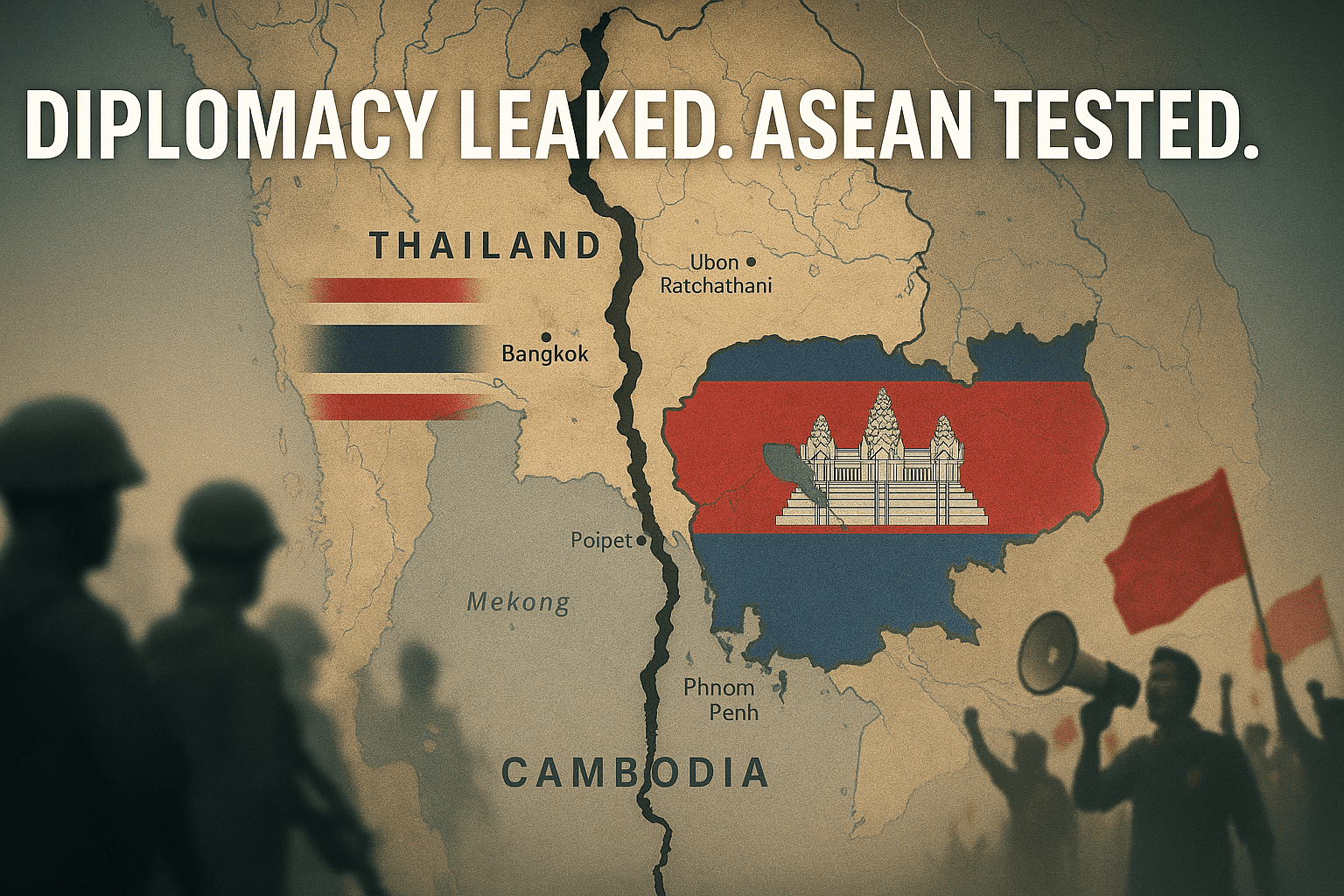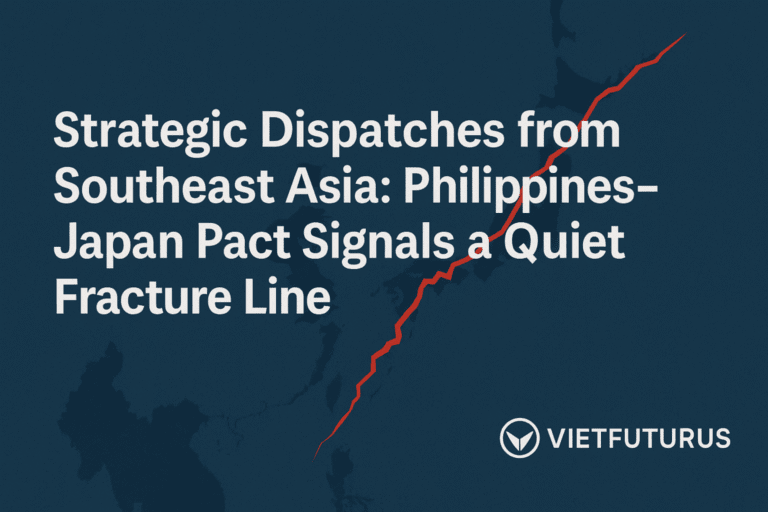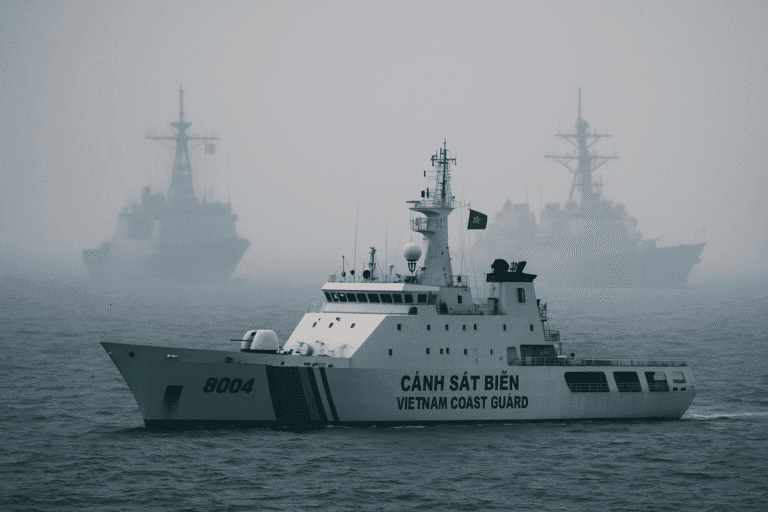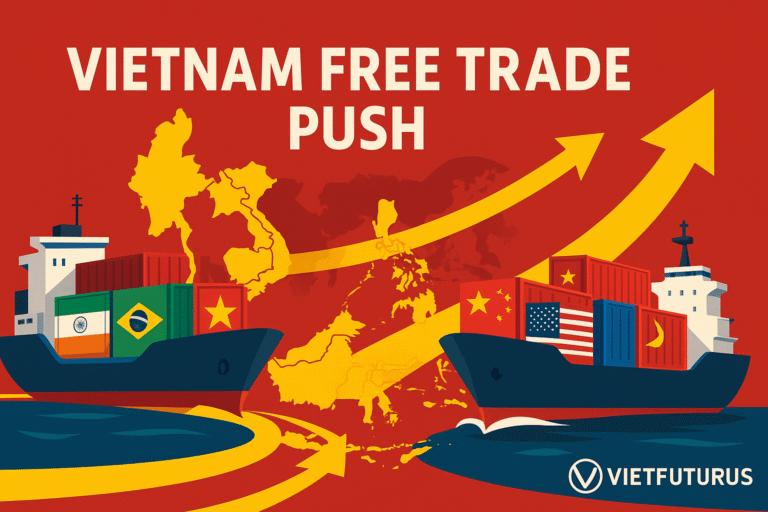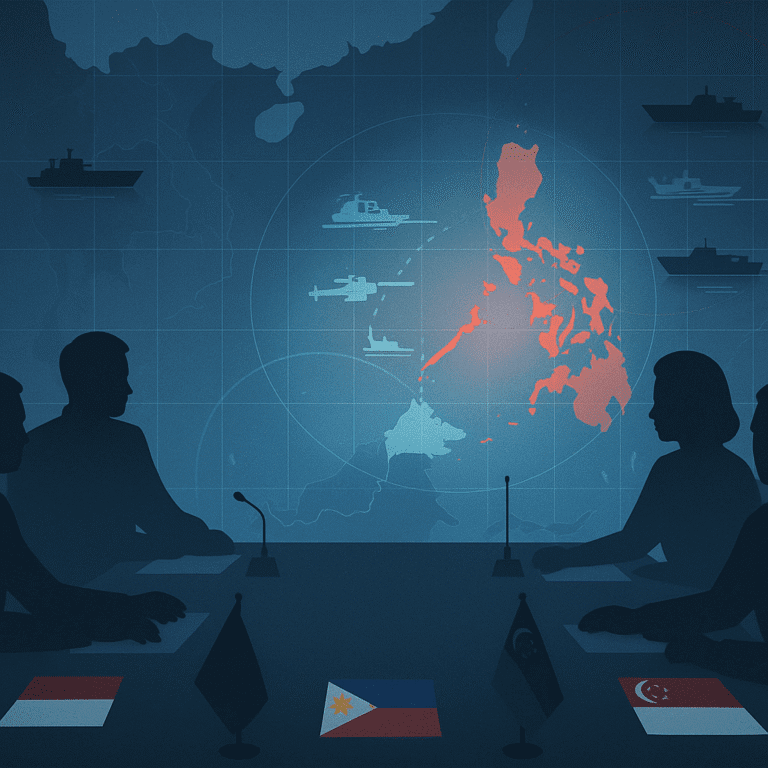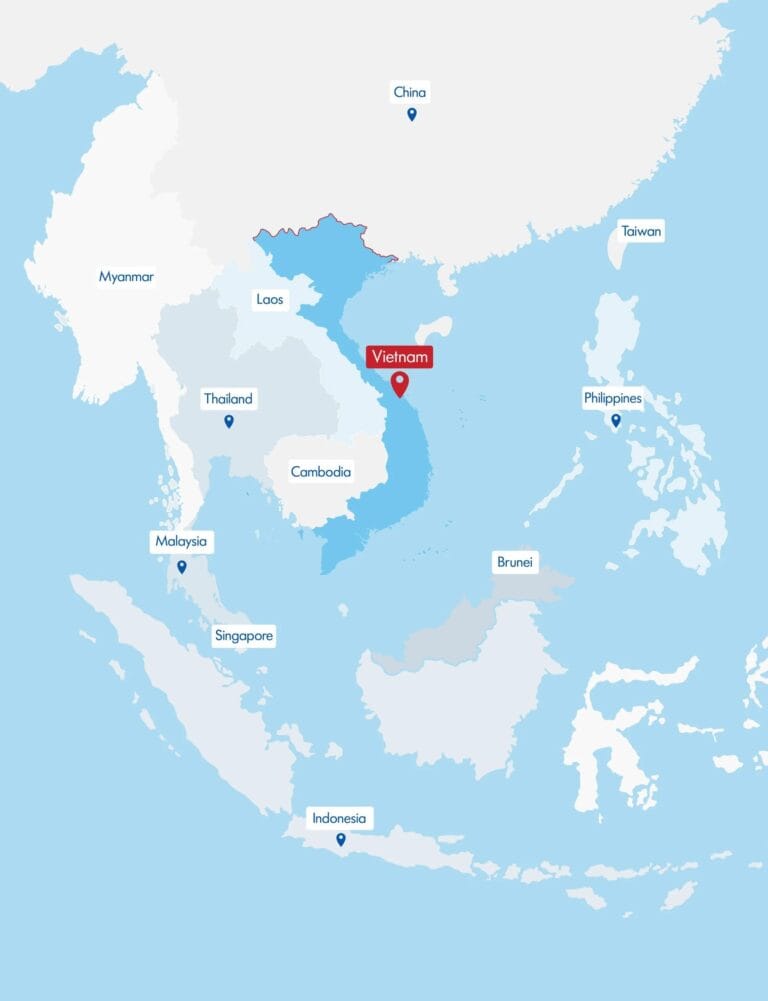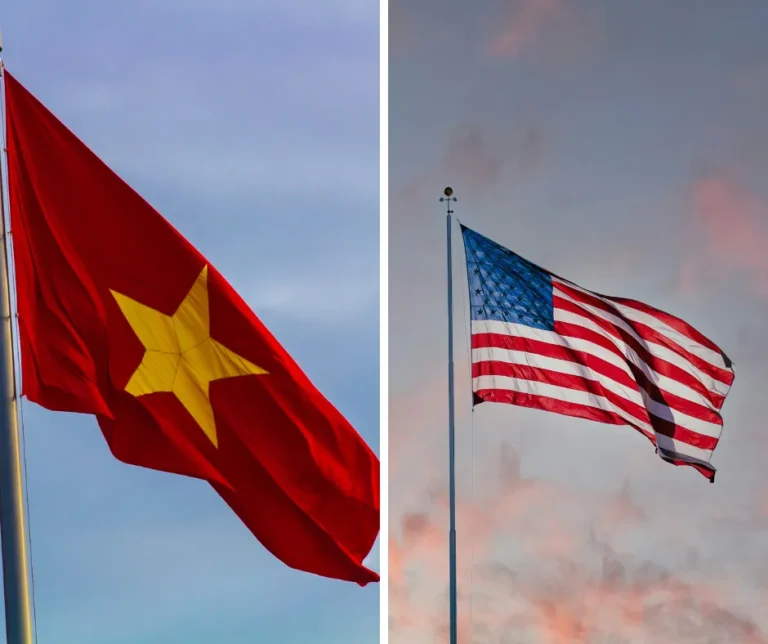Thailand-Cambodia Political Scandal: Fault Lines, Leaks, and the Limits of ASEAN Unity
The Thailand-Cambodia Political Scandal and the Future of Regional Stability
On June 18, 2025, a seemingly private phone call between Thai Prime Minister Paetongtarn Shinawatra and former Cambodian leader Hun Sen was leaked to the public. The content—intimate, unscripted, and diplomatically volatile—revealed the Thai leader appealing to her elder counterpart in Phnom Penh to help cool tensions after a border skirmish near Preah Vihear. But more controversial than the call itself was the tone: Paetongtarn referred to Hun Sen as “uncle,” appeared to criticize her own military, and suggested bypassing formal ASEAN channels.
Within 48 hours, Bangkok was engulfed in protests. Over 20,000 demonstrators flooded the streets, denouncing what they saw as a betrayal of national dignity. Thailand’s fragile 10-party coalition fractured, the Bhumjaithai Party withdrew its support, and nationalist groups revived slogans from the 2014 anti-Yingluck Shinawatra movement. Cambodia responded swiftly, closing key checkpoints, halting petroleum exports, and leveraging the incident to showcase its sovereignty on the regional stage.
This incident—the Thailand-Cambodia political scandal—is more than a diplomatic misstep. It is a fissure line running through Southeast Asia’s strategic architecture. It exposes cracks in Thailand’s civil-military balance, tests ASEAN’s outdated consensus mechanisms, and invites renewed interference from external powers seeking leverage in Indochina.
At a moment when Southeast Asia faces rising pressure to align with one great power bloc or another, the scandal reveals how internal vulnerabilities can rapidly spill into the regional sphere. If mishandled, this event risks becoming a precedent-setting crisis: one that will embolden future populist leaders, trigger copycat border assertiveness, and undermine the very principles ASEAN was built upon.
This paper unpacks the multilayered dimensions of the scandal—its domestic roots, geopolitical echoes, and economic ripples—and maps a policy-forward path to regional resilience. The future of Southeast Asia’s strategic balance may well hinge on how this moment is remembered, managed, or misused.
Domestic Fracture in Thailand Exposes Civil-Military Fault Lines
The Thailand-Cambodia political scandal shattered the illusion of internal unity in Bangkok, laying bare unresolved tensions between the civilian government and Thailand’s entrenched military elite.
What began as a diplomatic crisis quickly metastasized into a domestic political reckoning. Within hours of the audio leak on June 18, Thai nationalist groups, media outlets, and military-linked commentators seized upon Prime Minister Paetongtarn Shinawatra’s remarks as evidence of weakness, nepotism, and betrayal. In particular, her informal tone—referring to Hun Sen as “uncle” and speaking critically of her own armed forces—was read not as diplomatic pragmatism, but as familial overreach and a slight to Thailand’s defense establishment.
The scandal revived old ghosts: namely, the Shinawatra dynasty’s long-running struggle against military dominance in Thai politics. The subtext was unmistakable.
Coalition Collapse and Mass Mobilization
Within 72 hours of the leak, the Bhumjaithai Party—Thailand’s third-largest political bloc—announced its departure from the governing coalition. That move reduced Paetongtarn’s parliamentary support to a precarious 255 out of 500 seats, eliminating her ability to pass legislation or survive a no-confidence vote. The withdrawal was framed as a matter of “national integrity,” with Bhumjaithai citing a breach of protocol and lack of transparency in foreign affairs.
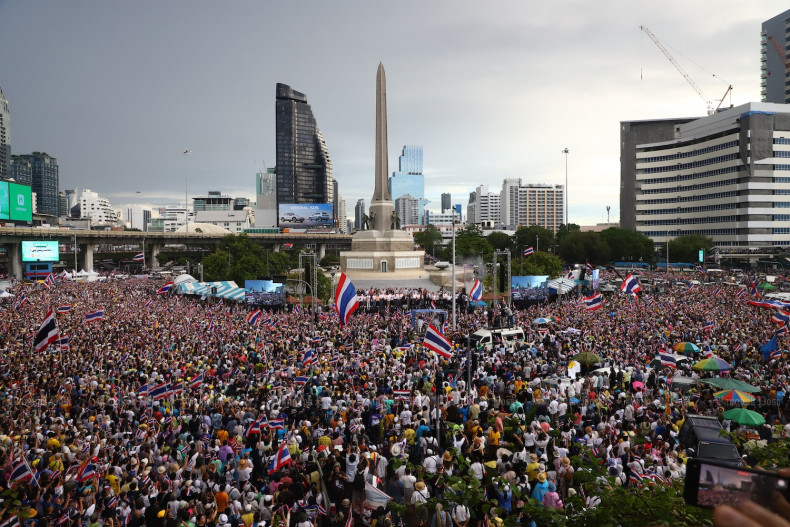
Simultaneously, Yellow Shirt protestors—largely silent since the 2023 general elections—re-emerged in force. The “United Force of the Land” coalition, backed by royalist and military-aligned networks, staged coordinated rallies in Bangkok, Korat, and Chiang Mai. Their demands echoed 2013-14: the resignation of the Prime Minister, the dissolution of Parliament, and a return to “true” Thai values.
This political theater was not organic. Behind it were networks long hostile to Shinawatra rule—networks with deep military and business ties. The scandal gave them a ready-made pretext.
Military’s Unspoken Leverage
While senior Thai generals avoided direct public confrontation, their posture was clear. The Commander-in-Chief of the Royal Thai Army issued a rare statement emphasizing the importance of “dignity and institutional respect” in international affairs. Though mild in tone, the message was read as a rebuke of the Prime Minister’s handling of the Cambodia situation.
Unofficially, multiple military sources hinted at dissatisfaction with civilian leadership. Paetongtarn’s lack of prior defense or foreign affairs experience, combined with her familial ties to the ousted Thaksin regime, made her a permanent target of suspicion. The armed forces—while not immediately threatening a coup—signaled a readiness to intervene should “national stability be endangered.”
This veiled threat created a chilling effect within the civilian cabinet, freezing key decisions and derailing crisis management during a critical 72-hour window after the leak.
Strategic Vacuum and Institutional Paralysis
Thailand’s response to the scandal was fragmented and reactive. The Prime Minister’s apology, issued two days after the leak, was delayed and defensive—focusing on betrayal rather than leadership. The Ministry of Foreign Affairs released no unified narrative. Meanwhile, Parliament stalled on critical defense coordination bills meant to support border de-escalation.
The absence of a national security crisis unit—independent of political maneuvering—allowed the scandal to spin unchecked. Media narratives proliferated. Conspiracy theories bloomed. Thailand’s reputation as a regional stabilizer eroded in real time.
Policy Recommendations
To prevent the next diplomatic scandal from igniting internal collapse, Thailand must:
- Codify civilian–military protocols for real-time crisis communication, including mandatory joint briefings during regional flashpoints.
- Create an independent Strategic Communications Unit within the Prime Minister’s Office to manage leaks, public narratives, and information warfare.
- Revise coalition governance rules, including pre-agreed crisis response compacts to prevent parliamentary paralysis under external stress.
- Institutionalize non-partisan national security councils that can act swiftly across administrations without triggering factional blowback.
The scandal revealed that Thailand’s greatest strategic liability may not lie at its borders—but within its own blurred lines of power.
Cambodian Strategic Opportunism and Sovereignty Narrative
The scandal gave Cambodia an unexpected geopolitical gift: the chance to reassert national sovereignty, reframe historical grievances, and position itself as a victim of regional disrespect—on its own terms.
For a small country long overshadowed by its neighbors and shaped by centuries of foreign intervention, Cambodia has mastered the art of geopolitical improvisation. When the leaked recording revealed Thai Prime Minister Paetongtarn Shinawatra privately seeking Hun Sen’s help and downplaying her own military’s stance, Phnom Penh seized the narrative before Bangkok could react.
Border Checkpoints as Instruments of Pressure
On June 21, within 72 hours of the leak, the Cambodian Ministry of Interior announced the indefinite closure of several key border crossings with Thailand: Sai Taku (Oddar Meanchey), Chong Sa-ngam (Si Sa Ket), and Buri Ram checkpoints—all critical arteries for informal trade and cross-border commerce.
The official rationale: “security concerns and respect for sovereign integrity.” Unofficially, the move sent a double message—domestically, it reaffirmed the government’s protective posture; externally, it signaled to Thailand that Cambodia would not tolerate condescension masked as diplomacy.
This border leverage caused immediate economic disruption. Cross-border truck shipments of Cambodian agricultural goods, garments, and rubber halted. Thousands of daily commuters—mostly informal traders and laborers—were turned back. Thailand’s local economies in Surin and Si Sa Ket provinces, reliant on border trade, began to feel the pain.
Cambodia’s calculated pain threshold was higher. With strategic stockpiles of fuel and food in place—and with Chinese-backed logistics routes on standby—Phnom Penh weathered the closure with minimal political cost.
Hun Sen’s Narrative Control: From Strongman to National Guardian
Though no longer Prime Minister, Hun Sen remains Cambodia’s most potent political actor. Within hours of the leak, he re-emerged on state television, calling Thailand’s behavior “disrespectful to the Cambodian people and our sacred border martyrs.” It was classic Hun Sen—blending personal grievance with historical trauma.
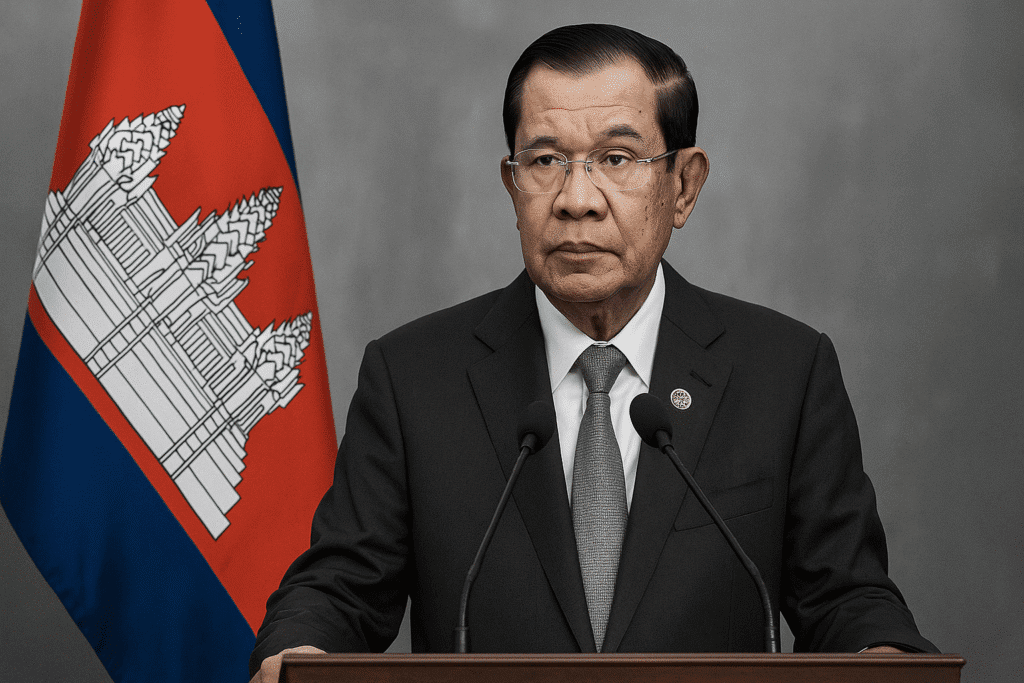
He invoked Cambodia’s painful history with Thailand: territorial disputes, cultural theft, and unequal power relations. But this time, the stage was regional. Hun Sen’s tone was not that of a provocateur, but of a statesman protecting a small nation’s pride in the face of a larger neighbor’s indiscretion.
On Facebook, Telegram, and government-affiliated media, the message was clear: Cambodia had been disrespected. The Prime Minister of Thailand had crossed a line. The people would not be silent. A nationalist rally in Phnom Penh on June 24 drew over 10,000 participants and became a televised spectacle of unity.
Shifting Regional Sympathy and ASEAN Leverage
Phnom Penh also moved swiftly within multilateral circles. Cambodia submitted a letter of concern to the ASEAN Secretariat, accusing Thailand of “undermining bilateral trust and violating regional norms of conduct.” Although mostly symbolic, this move framed Cambodia as the aggrieved party—contrasting with Thailand’s internal chaos and delayed response.
Notably, Vietnam and Laos issued cautious statements urging restraint “on both sides,” while Indonesia and Malaysia remained silent. But in regional diplomatic circles, Cambodia had already achieved its goal: appearing firm, composed, and sovereign—despite being the smaller power.
Hun Sen’s long-standing strategy of playing off larger rivals (China, Vietnam, the West) now adapted to a new front—leveraging intra-ASEAN rifts to secure symbolic capital.
Policy Recommendations
Cambodia’s opportunistic maneuvering offers both a warning and a model:
- For ASEAN: Rapid-response diplomacy mechanisms must be empowered to neutralize unilateral escalations like border closures that carry outsized regional impacts.
- For Thailand: Respectful, well-structured channels of informal diplomacy must be developed, particularly with neighbors who hold historical grievances.
- For future crisis actors: Small states can leverage asymmetric diplomacy—if narratives are swift, coherent, and emotionally resonant.
The scandal reveals that in Southeast Asia, hard power may win battles—but narrative sovereignty often wins the war.
Economic Spillovers and Investor Confidence
The Thailand-Cambodia political scandal did not remain confined to diplomatic or nationalist spheres—it sent shockwaves through regional markets, disrupted trade flows, and revealed the fragility of Southeast Asia’s economic interdependence.
In an era where politics, trade, and digital information are interwoven, diplomatic missteps have immediate financial consequences. The scandal’s rapid spread across social media, its impact on coalition politics, and border closure fallout shook investor confidence not only in Thailand and Cambodia but across the ASEAN economic corridor.
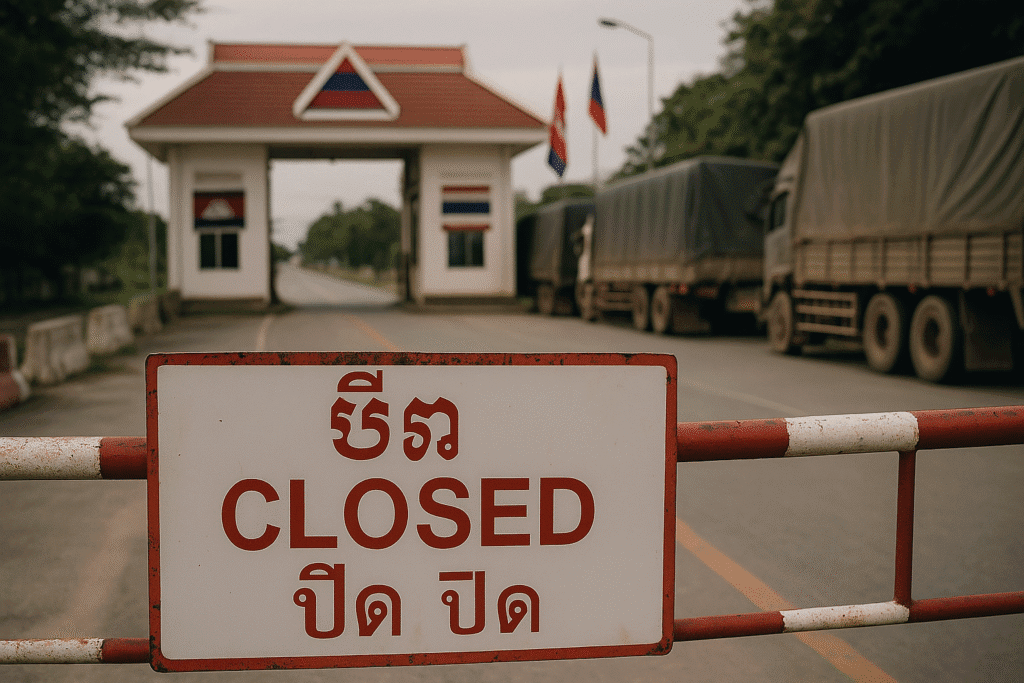
Market Volatility and Capital Outflows
Thailand’s SET Index reacted sharply within 24 hours of the leaked audio. From June 19 to June 21, the market lost over US $1.2 billion in capital value, driven by declines in transportation, border commerce, and logistics-linked equities. Notably, Thai oil distributor PTG Energy, a key supplier to Cambodian importers, saw a 7.3% dip.
Cambodia, though less directly exposed to capital markets, faced currency pressure. The riel dipped against the dollar amid fears of prolonged trade blockades. While the National Bank of Cambodia intervened, investor sentiment flagged—particularly among foreign-owned garment and textile factories near the Thai border.
Foreign direct investment (FDI) flows to Cambodia from Thailand also showed signs of suspension. Multiple Thai conglomerates, including CP Group, announced delays in planned agro-industry expansions in Kampong Thom and Battambang.
Markets dislike uncertainty—and nationalist scandals, especially those involving informal diplomacy, create precisely that.
Trade Disruption and Supply Chain Stress
Cambodia’s abrupt border closures hit bilateral trade hard. In 2024, Thai-Cambodian trade reached US $9.3 billion, with significant volumes flowing through terrestrial checkpoints now shuttered.
Key goods affected included:
- Cambodian rice, cashews, and textiles destined for Thai re-export hubs
- Thai fuel, machinery, and consumer goods critical for rural Cambodian supply chains
For Thailand, the economic pain was felt most acutely in Isaan border provinces—already economically fragile, now suddenly cut off from daily trade activity and cross-border labor flows.
For Cambodia, the fuel embargo’s effects began to surface in gas stations by June 25. While short-term reserves buffered immediate fallout, supply shortages loomed if closures extended beyond three weeks.
The risk is not just local—it is systemic. ASEAN’s dependence on seamless cross-border trade is a pillar of its integrated economy. The scandal revealed how easily that pillar can be shaken by nationalist politics.
Investor Sentiment Across ASEAN
Investors across the region began to reassess their risk models. While Singapore and Vietnam remained largely insulated, fund managers expressed concern over the reliability of ASEAN trade routes, especially for landlocked logistics.
Multinational firms, including Japanese electronics manufacturers operating along the Eastern Economic Corridor, raised contingency alarms. Cambodia, increasingly seen as a frontier market for affordable labor and Chinese supply-chain diversification, briefly slipped down investor watchlists.
Ratings agencies placed Thailand’s political outlook under review—not due to macroeconomic weakness, but political instability triggered by unresolved elite rivalries.
Policy Recommendations
To preserve ASEAN’s economic integrity in the face of bilateral crises, the following actions are urgent:
- Establish trade continuity protocols within the ASEAN Economic Community (AEC), including a “Border Disruption Emergency Clause” to keep essential goods flowing during political tensions.
- Create bilateral crisis trade task forces between neighboring countries, enabling real-time coordination during political disruptions.
- Incentivize cross-border SEZs (Special Economic Zones) to institutionalize interdependence and reduce the temptation for unilateral shutdowns.
- Enhance investor confidence mechanisms, including rapid market updates from central banks and ministries during political incidents.
The scandal reminds us that in Southeast Asia, political instability is no longer a domestic affair. The border is porous—not only to people and goods, but to fear, narrative, and financial volatility.
ASEAN’s Consensus Model Under Strain
The scandal exposed ASEAN’s chronic weakness: its inability to act swiftly and decisively when nationalism, pride, and bilateral tensions collide.
ASEAN’s identity has long been anchored in soft diplomacy, mutual respect, and the principle of non-interference. These norms have helped preserve peace amid diversity—but they also create inertia in times of rupture. As the Thailand-Cambodia crisis escalated from a private leak to a full-blown geopolitical incident, ASEAN’s mechanisms remained frozen—delivering symbolic concern but no actionable relief.
The price of that inaction may be rising.
Failure of Existing Conflict Mediation Channels
Within a week of the audio leak, both Thailand and Cambodia submitted letters to the ASEAN Secretariat—Thailand requested that the issue be treated as a “domestic matter,” while Cambodia called for a regional reaffirmation of border integrity norms.
ASEAN’s institutional response was muted. At the June 26 ASEAN Political-Security Community (APSC) coordination meeting, the bloc issued a brief statement urging “restraint and mutual respect” but declined to convene an emergency session. The ASEAN Regional Forum (ARF) remained inactive, and the ASEAN Defense Ministers’ Meeting (ADMM) sidestepped the issue altogether.
The silence was strategic—but also symptomatic. With its rotating chairmanship and norm of non-confrontation, ASEAN lacks both the mandate and courage to handle fast-moving crises between member states. When bilateral disputes escalate, the region relies on informal diplomacy and backchannel appeasement—methods ill-suited to the digital speed and nationalist virality of 2025.
Undermining Regional Unity from Within
The scandal also surfaced deeper structural risks to ASEAN cohesion. Cambodia’s move to escalate the incident—rather than resolve it privately—signaled a shift in small-state behavior. Unlike past episodes, Phnom Penh did not fear being labeled disruptive; it embraced the role of sovereign challenger.
This emboldened stance may inspire similar moves from other member states harboring bilateral grievances—Vietnam with China over maritime boundaries, Malaysia and the Philippines over Sabah, or Indonesia with Timor-Leste.
Moreover, ASEAN’s inability to mediate in real time made space for external powers to deepen bilateral alignments—undermining the bloc’s centrality narrative.
Thailand, isolated and facing internal upheaval, turned to traditional allies like Japan and the United States for statements of support. Cambodia re-engaged with Chinese advisors and military envoys. These external recalibrations, occurring within days, signaled that ASEAN was not the first call in a crisis—it was the last resort.
ASEAN’s Non-Interference Doctrine in Crisis
The very principle that once allowed ASEAN to function across ideological divides—non-interference—is now eroding its relevance. While originally intended to protect sovereignty, it has become a barrier to regional problem-solving. The scandal showed that:
- Internal crises can have regional economic and security consequences
- Bilateral tensions can quickly acquire regional dimensions
- Avoiding “mediation” allows problems to metastasize
The risk is clear: if ASEAN cannot evolve its model, its strategic centrality will collapse under the weight of its own neutrality.
Policy Recommendations
ASEAN must treat this scandal not as an exception, but as a stress test:
- Establish a Rapid Response Mechanism (RRM) under the ASEAN Secretariat, with power to convene emergency dialogues within 72 hours of an intra-bloc diplomatic incident.
- Empower the ASEAN Chair with Crisis Mediation Authority, even in bilateral disputes, while maintaining neutrality through third-party observers.
- Revise the Treaty of Amity and Cooperation (TAC) to include a protocol for managing digital-era diplomatic leaks and nationalist escalation.
- Invest in a permanent ASEAN Crisis Observatory, tracking emerging tensions, cross-border narratives, and hybrid threats before they erupt.
The Thailand-Cambodia political scandal is a symptom of a broader problem: ASEAN diplomacy was built for a slower world. In the age of leaks, livestreams, and leaderless protest movements, it must either adapt—or fade.
External Power Competition in Indochina
The Thailand-Cambodia political scandal has not just unsettled bilateral ties—it has redrawn the battlefield for influence in mainland Southeast Asia, as great powers move quickly to fill ASEAN’s diplomatic void.
For Washington and Beijing, the scandal is more than a local rupture. It is an opportunity to reinforce alliances, test strategic footholds, and quietly reshape the region’s power geometry. With ASEAN paralyzed and public trust eroding in both capitals, Cambodia and Thailand have become ripe terrain for outside recalibration.
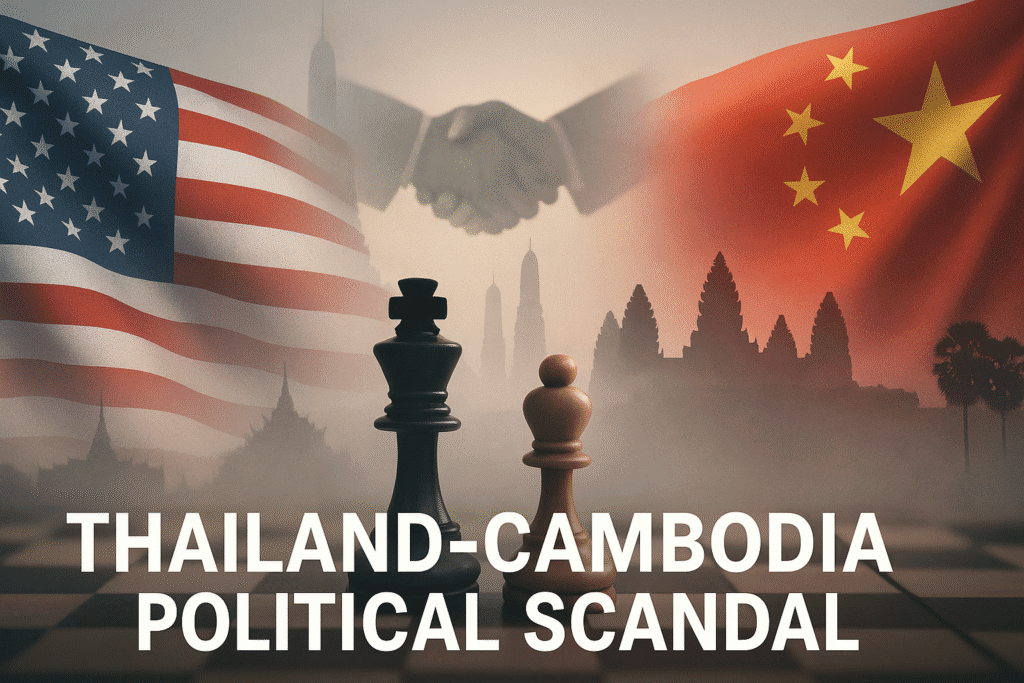
China’s Calculated Reinforcement in Cambodia
China was the first to respond—quietly, but decisively. On June 23, just five days after the leak, a delegation from the Chinese Ministry of State Security arrived in Phnom Penh under the guise of “technical support for digital infrastructure resilience.” By June 25, Cambodia had announced a new Memorandum of Understanding with Huawei to bolster its National Data Centre, citing “cybersecurity enhancements amid rising digital risks.”
The timing was not coincidental.
For years, Cambodia has leaned heavily on Beijing for strategic infrastructure, including the controversial Ream Naval Base, Belt and Road corridors, and surveillance technology. Now, the scandal offered China a chance to double down—portraying itself as a stabilizing partner offering “respectful” diplomacy in contrast to Thailand’s misstep.
China also moved symbolically. On June 28, it fast-tracked a previously stalled grant to build a Cambodia–China Cultural Friendship Park in Siem Reap, aimed at “deepening mutual understanding and historical ties.” The message: when neighbors disrespect you, turn to your true patron.
U.S. Response: Hedging, Not Leading
The United States, in contrast, reacted with caution. The U.S. Embassy in Bangkok issued a muted statement urging “dialogue and democratic resolution” but avoided direct criticism of either government. It wasn’t until June 25 that a State Department spokesperson acknowledged the scandal’s broader implications for regional stability.
Still, U.S. moves were not absent—they were more strategic than theatrical.
- U.S. Pacific Command re-engaged Thailand on joint military exercises, proposing expanded Cobra Gold drills focused on civil-military communication and cybersecurity.
- The Millennium Challenge Corporation (MCC) quietly resumed preliminary talks with Cambodia about aid reinstatement—paused since 2017 over governance concerns.
- Washington also leaned on its QUAD partners—especially Japan—to issue synchronized statements of support for “rule-based engagement” in the region, subtly framing China’s deepening Cambodia presence as destabilizing.
Yet America’s dilemma remains: its values-based diplomacy often alienates Southeast Asian elites, even as its security guarantees remain desirable.
A New Phase of Strategic Triangulation
The scandal has triggered what analysts increasingly call “ASEAN Triangulation 2.0”: a new phase in which Southeast Asian states no longer merely balance U.S.–China rivalry, but actively manipulate it to extract advantage.
- Cambodia now leverages Chinese loyalty while hinting at openness to U.S. normalization—playing both sides for maximum strategic gain.
- Thailand, caught in internal crisis, retreats from ASEAN centrality while drawing reassurance from Washington’s implicit backing of constitutional order.
This dynamic undermines the very principle of ASEAN neutrality, replacing it with transactional alignments based on immediate crisis needs rather than long-term regional vision.
Policy Recommendations
If ASEAN is to remain a relevant platform for regional order amid great-power tug-of-war, it must evolve:
- Draft a “Strategic Engagement Charter” that articulates clear principles for how member states manage and disclose bilateral deals with extra-regional powers during times of crisis.
- Create an ASEAN External Influence Monitor, tracking military, digital, and investment inroads by China, the U.S., and others to build transparency and shared risk awareness.
- Promote ASEAN-plus formats (e.g., ASEAN+3, EAS) not just as forums, but as buffer zones where regional interests can be consolidated before great-power penetration deepens.
The Thailand-Cambodia political scandal didn’t just expose domestic fragility—it illuminated how fast external actors can capitalize on ASEAN’s silence. Without a recalibrated collective posture, Indochina risks becoming not a bridge between powers—but a proxy battleground.
Strategic Communication and Crisis Management
In an era of instantaneous leaks and virality, the Thailand-Cambodia political scandal shows that the first casualty of mismanaged diplomacy is not truth—but narrative control.
What elevated this crisis from routine border tension to regional rupture wasn’t just what was said—it was how, when, and where it was heard. The scandal’s epicenter was not a battlefield or a courtroom, but a viral voice recording circulating on Telegram, Twitter (X), and Line within hours of its release. As nationalist influencers on both sides stoked outrage, political actors were left scrambling—not to respond to an incident, but to regain control of the story.
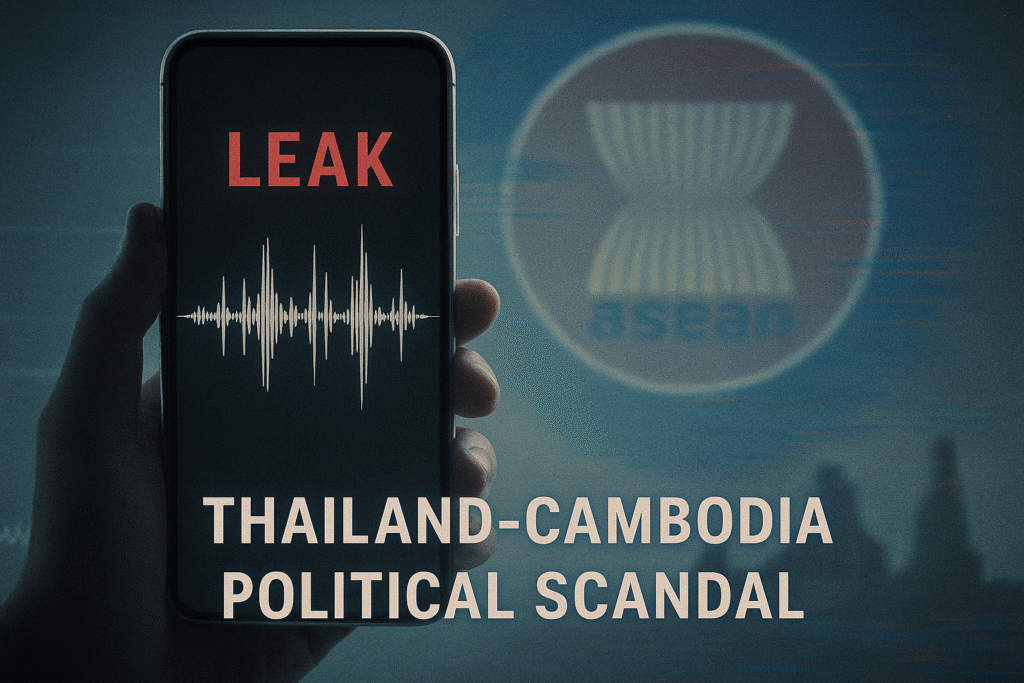
Diplomatic Vulnerability in the Digital Age
The phone call in question—a 14-minute audio clip of Thai PM Paetongtarn Shinawatra speaking candidly with former Cambodian PM Hun Sen—was never meant for public ears. Initial investigations suggest it was conducted over a non-secure line, possibly via a private mobile device, without encryption or oversight by Thailand’s Ministry of Foreign Affairs.
This exposed two systemic failures:
- No standardized communication protocol for informal diplomacy, even amid a border crisis.
- No pre-approved escalation contingency in case of media leaks or intercepted conversations.
The result? Once the clip was leaked—believed to be through a pro-military whistleblower inside Thailand—the government lost the initiative. There was no rapid messaging, no clarification, and no trusted voice to reframe the narrative.
In the absence of strategic communication, memes, mistranslations, and manipulated transcripts filled the void.
Public Messaging Breakdown
Thailand’s delayed apology—issued two days later—was widely seen as tone-deaf. It focused on “betrayal by insiders” rather than showing empathy or accountability. The phrasing, “It was a conversation between friends, not governments,” fell flat in the face of public rage and military agitation.
By contrast, Cambodia executed a textbook crisis PR campaign. Within hours, Hun Sen addressed the public directly, expressing “shock and sadness” while asserting Cambodia’s national dignity. He provided no apology—only controlled outrage, which played well to domestic audiences.
In this asymmetry of response, the informational battlefield was lost before formal diplomacy even began.
Crisis Fatigue and Institutional Distrust
For citizens already disillusioned by opaque governance, the scandal confirmed what many suspected: power operates in shadows, and the public is only informed through leaks. This dynamic—seen across Southeast Asia from the Philippines to Malaysia—has eroded trust in official institutions.
The greater danger is crisis fatigue. When every scandal unfolds online before it is managed on the ground, both diplomats and citizens become desensitized—expecting drama, not resolution.
Policy Recommendations
Southeast Asia’s governments must prepare for a new kind of war: one where information moves faster than policy, and perception trumps principle. To that end:
- Implement encrypted, auditable communication protocols for all diplomatic conversations, especially during conflict de-escalation periods.
- Create National Strategic Communications Units (NSCUs) empowered to issue public briefings, manage narrative framing, and combat disinformation within minutes of a breach.
- Train leadership in narrative intelligence—understanding not just what is said, but how it will be heard in a hyper-polarized digital landscape.
- Design ASEAN-wide rapid response media drills, simulating regional crisis leaks and coordinating member state messaging to maintain unity.
The region’s next scandal won’t be stopped by censorship or silence. It will be mitigated by trustworthy, agile, and transparent communication strategies—deployed before virality sets the agenda.
Conclusion: From Scandal to Strategy—A Regional Turning Point
The Thailand-Cambodia political scandal has become more than a bilateral embarrassment—it is a strategic inflection point for Southeast Asia. What began as a leaked phone call intended to ease tensions after a deadly border skirmish quickly evolved into a cascading regional crisis: collapsing political coalitions in Bangkok, igniting nationalist fervor in Phnom Penh, halting trade, rattling markets, and revealing ASEAN’s crisis-handling limitations in real time.
The scandal is not remarkable for its spark, but for how flammable the system had become:
- Thailand’s internal civil-military instability cracked open under narrative pressure.
- Cambodia, often dismissed as a minor actor, deftly flipped the script to elevate its standing.
- External powers—China and the U.S.—seized the vacuum, accelerating a new scramble for influence in Indochina.
- ASEAN, long lauded for quiet consensus, remained mute as its credibility thinned in the face of digital diplomacy and asymmetric escalation.
This is a warning—and a window. The region can no longer afford to rely on legacy assumptions: that informal ties will smooth tensions, that sovereignty will shield states from information warfare, that economic interdependence alone ensures peace.
Instead, Southeast Asia must evolve:
- Codify regional crisis management protocols that match the velocity of modern scandals.
- Modernize strategic communication systems to pre-empt disinformation and restore public trust.
- Reframe neutrality not as passivity, but as strategic positioning—capable of balancing great-power rivalry while protecting internal cohesion.
- Institutionalize preventive diplomacy, not just reactive diplomacy.
This paper has mapped the shockwaves of one scandal. The next may come faster, louder, and from an unexpected source—be it another leak, a cyber-breach, or a misread military maneuver.
Call to Action: ASEAN foreign ministers must convene before the end of Q3 2025 to adopt binding reforms in crisis response, cross-border communication, and digital information security. The region’s strategic ambiguity—once its strength—must now evolve into strategic clarity, before the next flashpoint finds ASEAN unprepared again.
Because what cracked open between Thailand and Cambodia was not just a diplomatic misunderstanding—but a preview of the geopolitical turbulence to come.

